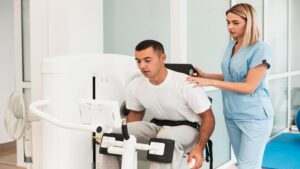At Carvolth Physiotherapy, we take a comprehensive and personalized approach to Post operative Rehabilitation, tailoring our programs to meet your specific needs and goals. Our multidisciplinary team of healthcare professionals collaborates closely to provide you with the highest level of care, combining advanced techniques and compassionate support to guide you through every step of your recovery journey.
Our Post operative Rehabilitation
Pain Management: Effective pain management is essential to ensure comfort and facilitate progress in rehabilitation. Strategies may include medications, cold or heat therapy, and relaxation techniques. Monitoring pain levels and adjusting treatment plans as necessary helps maintain a balance between managing discomfort and encouraging mobility.
Mobility Exercises: Early mobility exercises are vital to prevent stiffness and promote circulation. These exercises, tailored to the individual’s condition and stage of recovery, focus on gentle movements to improve range of motion and gradually increase activity levels. Techniques may involve passive, active-assisted, and active range-of-motion exercises, depending on the patient’s capabilities and needs.
Strength Training: As recovery progresses, strength training becomes increasingly important to rebuild muscle strength and endurance. This involves targeted exercises designed to restore muscle function and support joint stability. Exercises may include resistance bands, free weights, or body-weight movements, adjusted to avoid overloading the healing tissues.

Functional Training: Functional training aims to enhance the patient’s ability to perform daily activities and regain independence. This includes practicing tasks such as walking, climbing stairs, or lifting objects in a controlled and safe manner. Functional training helps translate improvements from exercises into real-world activities, promoting overall quality of life.
Manual Therapy: Manual therapy techniques, such as joint mobilizations and soft tissue massage, are used to alleviate pain, improve joint mobility, and reduce muscle tension. These hands-on approaches are often integrated with other rehabilitation modalities to address specific issues and enhance recovery.
Education and Home Exercise Program: Educating patients about their condition, recovery process, and self-care strategies is crucial. A personalized home exercise program helps maintain progress between therapy sessions, focusing on exercises and activities that patients can perform independently. This program empowers patients to take an active role in their recovery and ensures continuity of care.
Post operative Rehabilitation
Benefits of Post Operative Rehabilitation
Post operative rehabilitation is crucial for optimizing recovery and ensuring the best possible outcomes after surgery. One effective technique used in this process is dry needling, which offers several notable benefits.
Faster Recovery: Dry needling can accelerate the healing process by targeting muscle trigger points and improving blood flow. This enhanced circulation aids in the quicker repair of tissues and reduces downtime, allowing patients to return to their normal activities more swiftly.
Improved Function: By addressing muscular dysfunctions and reducing pain, dry needling helps restore normal movement patterns and muscle function. This can lead to better overall physical performance and increased strength, which are vital for regaining full mobility after surgery.
Pain Relief: One of the primary advantages of dry needling is its ability to provide significant pain relief. The technique involves inserting thin needles into specific points in the muscle, which can help alleviate muscle tension and discomfort. This relief can be particularly beneficial in the post operative period when managing pain is a key concern.
Prevention of Complications: Effective management of pain and muscle dysfunction through dry needling can prevent complications such as muscle imbalances and poor movement patterns. Addressing these issues early on reduces the risk of developing chronic pain or other post-surgical complications.
Enhanced Quality of Life: Ultimately, dry needling contributes to a better quality of life by promoting a faster and more efficient recovery. With reduced pain and improved function, patients are better equipped to resume their daily activities and enjoy a higher level of comfort and well-being.
Incorporating dry needling into post operative rehabilitation can therefore provide a range of benefits, from speeding up recovery and enhancing physical function to alleviating pain and preventing further complications.
Post operative Rehabilitation
Ready to optimize your recovery and regain your independence after surgery? Contact us today to schedule your consultation and learn more about our post-operative rehabilitation programs at Carvolth Physiotherapy.
 778-298-1111
778-298-1111  20290 86 Ave,Langley
20290 86 Ave,Langley

